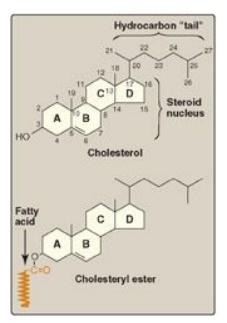Structure of Cholesterol
| Home | | Biochemistry |Chapter: Biochemistry : Cholesterol, Lipoprotein, and Steroid Metabolism
Cholesterol is a very hydrophobic compound. It consists of four fused hydrocarbon rings (A-D) called the “steroid nucleus,” and it has an eight-carbon, branched hydrocarbon chain attached to carbon 17 of the D ring.
STRUCTURE OF CHOLESTEROL
Cholesterol is a very
hydrophobic compound. It consists of four fused hydrocarbon rings (A-D)
called the “steroid nucleus,” and it has an eight-carbon, branched hydrocarbon
chain attached to carbon 17 of the D ring. Ring A has a hydroxyl group at
carbon 3, and ring B has a double bond between carbon 5 and carbon 6 (Figure
18.2).

Figure 18.2 Structure of cholesterol and its ester.
A. Sterols
Steroids with eight to
ten carbon atoms in the side chain at carbon 17 and a hydroxyl group at carbon
3 are classified as sterols. Cholesterol is the major sterol in animal tissues.
It arises from de novo synthesis and absorption of dietary cholesterol. [Note:
Intestinal uptake of cholesterol is mediated, at least in part, by the protein
Niemann-Pick C1-like 1 protein (NPC1-L1), the target of the drug ezetimibe that
reduces absorption of dietary cholesterol. Plant sterols (phytosterols), such
as β-sitosterol, are poorly absorbed by humans (5% absorbed as compared to 40%
for cholesterol). After entering the enterocytes, they are actively transported
back into the intestinal lumen. Defects in the transporter result in the rare condition
of sitosterolemia. Because some cholesterol is transported back as well, plant
sterols reduce the absorption of dietary cholesterol. Daily ingestion of plant
sterol esters supplied, for example, in spreads or juices, is one of a number
of dietary strategies to reduce plasma cholesterol levels.]
B. Cholesteryl esters
Most plasma cholesterol
is in an esterified form (with a fatty acid attached at carbon 3, as shown in
Figure 18.2), which makes the structure even more hydrophobic than free
(unesterified) cholesterol. Cholesteryl esters are not found in membranes and
are normally present only in low levels in most cells. Because of their
hydrophobicity, cholesterol and its esters must be transported in association
with protein as a component of a lipoprotein particle or be solubilized by
phospholipids and bile salts in the bile.
Related Topics
